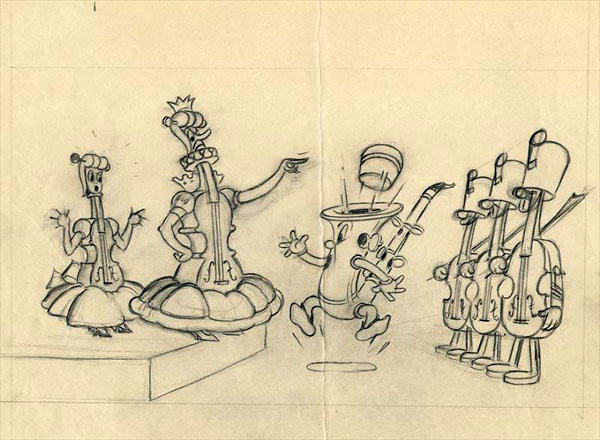
Come to the Land of Symphony, or maybe you’d like to sail over to the Isle of Jazz, in this week’s breakdown!
The story outline for Music Land, populated by humanized musical instruments separated by two opposing islands of classical and jazz music, circulated around the studio around December 19, 1934. Story artist Bill Cottrell noted Pinto Colvig as part of the story team in a production memo. Animator Grim Natwick recalled Ted Sears’ involvement during story development, as well; Sears suggested how the hero, a boy saxophone from the Isle of Jazz, escapes his imprisonment in the Land of Symphony after several ideas were rejected, which ended up in the film. Surviving story sketches reveal Earl Hurd—the patented inventor of the cel process in animation and creator of his own animated series, with child character Bobby Bumps, during the teens—contributed to the story.
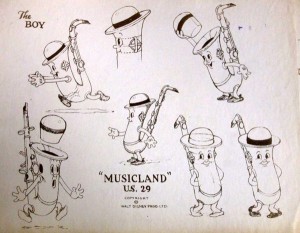 As with many Disney cartoons during this period, the animators are cast by sequence—Dick Lundy animates the flirtation between the Prince of Jazz, the boy saxophone, and the Princess of Symphony, a girl violin; Lundy’s animation in his work on the film, particularly on the princess coming down the steps to meet him, to the accompaniment of F.J. Gossec’s “Gavotte,” prefigures his musical timing as a director for Walter Lantz a decade later. Frenchy de Tremaudan handles the following sequences of the queen interfering, as the boy is marched away to confinement inside of a large metronome. Dick Huemer animates the scenes of the boy and girl during the warfare between the two islands, and the settlement, which ends their hostility.
As with many Disney cartoons during this period, the animators are cast by sequence—Dick Lundy animates the flirtation between the Prince of Jazz, the boy saxophone, and the Princess of Symphony, a girl violin; Lundy’s animation in his work on the film, particularly on the princess coming down the steps to meet him, to the accompaniment of F.J. Gossec’s “Gavotte,” prefigures his musical timing as a director for Walter Lantz a decade later. Frenchy de Tremaudan handles the following sequences of the queen interfering, as the boy is marched away to confinement inside of a large metronome. Dick Huemer animates the scenes of the boy and girl during the warfare between the two islands, and the settlement, which ends their hostility.
Les Clark animates the boy inside the prison, writing a note—in actually, “The Prisoner’s Song” on sheet music—and having a bird deliver the message to his father, the King of Jazz, a caricature of popular bandleader Paul Whiteman, often touted as “The King of Jazz.” (That title lent itself into a 1930 musical revue by Universal, recently restored and screened to modern audiences.) These scenes aren’t credited on the “semi-final” draft, but are confirmed by the exposure sheets for the film. Clark also animates the double wedding, between the prince and princess, and the king and queen.
 One animator, Gerry Geronimi, primarily handles scenes with one character; Geronimi animates many of the scenes of the King in his palace, including a risqué moment, showing his amusement with a female ukulele dressed in a hula skirt. Others struggled with the material—in later years discussing the film with John Culhane, Grim Natwick thought musical instruments were not pliable enough for animation, dismissing the characters as cold and benign. Natwick animates the string instruments dancing to Beethoven’s “Minuet in G” in the opening, which he found difficult.
One animator, Gerry Geronimi, primarily handles scenes with one character; Geronimi animates many of the scenes of the King in his palace, including a risqué moment, showing his amusement with a female ukulele dressed in a hula skirt. Others struggled with the material—in later years discussing the film with John Culhane, Grim Natwick thought musical instruments were not pliable enough for animation, dismissing the characters as cold and benign. Natwick animates the string instruments dancing to Beethoven’s “Minuet in G” in the opening, which he found difficult.
Music Land uses a large abundance of special effects—water, smoke, and explosions, especially during the battle sequences. Cy Young and Ugo D’Orsi, two of the studio’s chief effects animators, are credited for their effects work in the draft. However, other documents–such as exposure sheets, sweatbox notes and department ratings, which scrutinized animator’s footage and quality of their work—reveal other effects animators on the film. Some of these artists include George Rowley, Dan MacManus, Ed Aardal, George Drake and Jim Tyer, who left Van Beuren to improve his animation at Disney’s. Frank Thomas, later a top animator, was relatively new during the production of this film. He recalled animating the musical notes, falling like confetti, during the wedding scenes, to which he said: “I could’ve been an effects animator!”
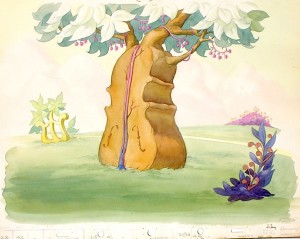 Leigh Harline, the musical composer of this film, worked closely with director Wilfred Jackson on his cartoons. Jackson felt Harline’s music was more “symphonic” than the scores studio musician Frank Churchill provided, appropriate in context of the film’s story. During the barrage fired between the two islands, the King’s vibrant brass/woodwind battleship attacks with a Harline original, while the Queen responds to an organ bombardment, blaring Wagner’s “Ride of the Valkyries.” As the princess waves a white flag and rows to the opposing island to disrupt the battle, the score combines the two compositions together, accompanied in a threatening hostility. At the end of the film, a Bridge of Harmony is shown spanning across the two islands, uniting them both; as the instruments celebrate, the score displays a certain community transforming, with symphony and jazz merging together as one.
Leigh Harline, the musical composer of this film, worked closely with director Wilfred Jackson on his cartoons. Jackson felt Harline’s music was more “symphonic” than the scores studio musician Frank Churchill provided, appropriate in context of the film’s story. During the barrage fired between the two islands, the King’s vibrant brass/woodwind battleship attacks with a Harline original, while the Queen responds to an organ bombardment, blaring Wagner’s “Ride of the Valkyries.” As the princess waves a white flag and rows to the opposing island to disrupt the battle, the score combines the two compositions together, accompanied in a threatening hostility. At the end of the film, a Bridge of Harmony is shown spanning across the two islands, uniting them both; as the instruments celebrate, the score displays a certain community transforming, with symphony and jazz merging together as one.
J.B. Kaufman and Russell Merritt’s updated and revised edition of Walt Disney’s Silly Symphonies: A Companion to the Classic Cartoon Series will be available in a few weeks. Pre-order your copy now! I have another Silly Symphony post for next week. After that one, there will be a breakdown that some of you will least expect—even I was surprised material from this particular series existed. Just wait and see.
Enjoy!
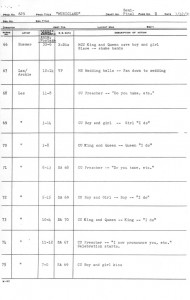
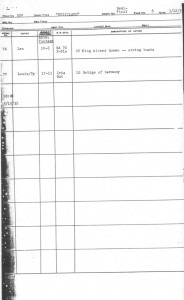
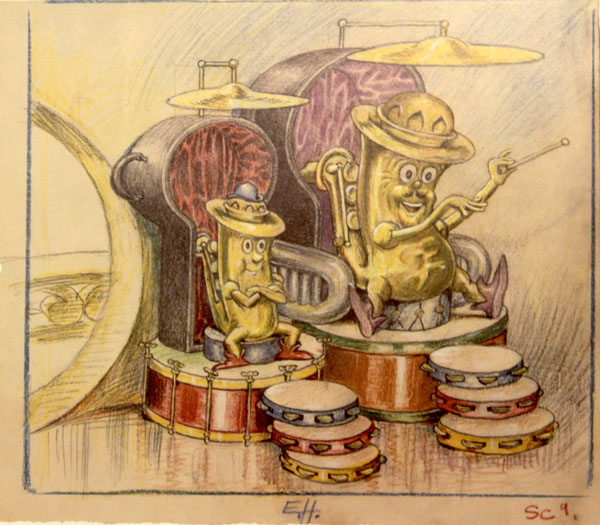


(Thanks to J.B. Kaufman, Didier Ghez and Michael Barrier for their help.)



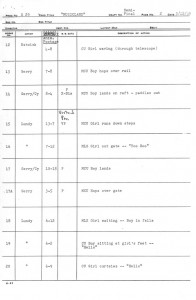


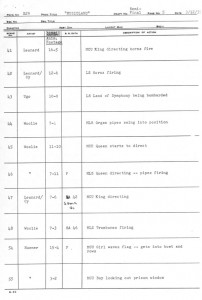

 DEVON BAXTER is a film restoration artist, video editor, and animation researcher/writer currently residing in Pennsylvania. He also hosts a
DEVON BAXTER is a film restoration artist, video editor, and animation researcher/writer currently residing in Pennsylvania. He also hosts a 





















































































This is one of my all time favorite Silly Symphony cartoons! Using real musical instruments as the voices of the characters (violin-the Princess,Viola-the no nonsense Queen of the Land of Symphony,Alto Saxophone-The Prince,Tenor or Baritone Saxophone-The fun loving King of the Isle of Jazz, and. A Bass Violin ((aka Upright Bass,Bass Fiddle))-Justice of the Peace) was pure genius! This reflects around the time the older generation (who grew up listening to Classical Music clashed with the younger generation who discovered Jazz Music and to the chagrin to the older generation loving that musical style. My favorite scene is when The Queen of The Land of Symphony counter attacks The King of Jazz’s jazz rifts by using Pipe Organ pipes as long range cannons blasting The Isle of Jazz with Wagner’s Ride of the Valkyries from The Ring. And the score was really fantastic as well!
This is an amazing cartoon. It is astounding how much of the “action” is represented by the score, but that is obvious when you note the title of this short. I’m sure it is one of the highlights of that SILLY SYMPHONIES soundtrack package from the Disney Legacy collection–and I am still hoping for a CD version, someday (sigh). And when is “THE KING OF JAZZ” coming in its restoration on DVD?
In Christopher Finch’s book “The Art of Walt Disney” released in the early 70’s, several pages are devoted to “Music Land” in the chapter “Six Cartoon Classics.” Before ever seeing the cartoon short, I first encountered it in this book. It’s a great read for any Disney fan.
I also first learned of this short through Finch’s book, and it it one of my favorites of the series. Beautifully animated and just really representative of what the concept of the Silly Symphonies embodied.
Even though I’ve seen bits and pieces of this, I saw a recent Simpsons couch gag that spoofed this entire film…..they certainly aiming for the cartoon buffs these days……..walked away knowing they may be running out of ideas when I could be watching the real thing on YouTube. Why not spoof a Paramount cartoon for a couch gag?
Anyways, this is a great cartoon. Had no idea almost every Disney animator at the time worked on this short. Guess they were one step further to completing Snow White!
And, of course, the story idea is loosely based on Shakespeare’s Romeo and Juliet .
With a genuine Disney happy ending of course!
“…doth with their *near*-death bury their parents’ strife…”
I really love this cartoon. To me this is one of the pivotal Silly Symphonies. Too bad it contains not a single note of jazz, and that it features Paul Whiteman as the genre’s representative, not any of the much hotter black bandleaders of the time (e.g. Duke Ellington, Cab Calloway, Jimmie Lunceford, Fletcher Henderson), or at least new star Benny Goodman, who broke through in 1935, and soon became “the king of swing”.
What would be a better description of the music featured in the cartoon? “Swing”?
The level of highly inventive gags repurposing musical instruments as anthropomorphic characters, buildings, weapons, vehicles, etc. in this cartoon makes it seem to me the most “Fleischer-esque” of the Silly Symphonies.
Interesting, Les Clark also animated the double-wedding in 101 Dalmatians. 🙂